Planning worship?
Check out our sister site, ZeteoSearch.org,
for 20+ additional resources related to your search.
- |
User Links
Person Results
S. Baring-Gould
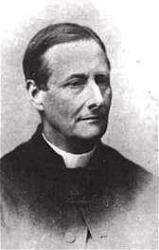
1834 - 1924 Person Name: Sabine Baring-Gould (1834-1924) Scripture: Luke 11:1 Composer of "EUDOXIA" in The Hymnbook Baring-Gould, Sabine, M.A., eldest son of Mr. Edward Baring-Gould, of Lew Trenchard, Devon, b. at Exeter, Jan. 28, 1834, and educated at Clare College, Cambridge, B.A. 1857, M.A. 1860. Taking Holy Orders in 1864, he held the curacy of Horbury, near Wakefield, until 1867, when he was preferred to the incumbency of Dalton, Yorks. In 1871 he became rector of East Mersea, Essex, and in 1881 rector of Lew Trenchard, Devon. His works are numerous, the most important of which are, Lives of the Saints, 15 vols., 1872-77; Curious Myths of the Middle Ages, 2 series, 1866-68; The Origin and Development of Religious Belief, 2 vols., 1869-1870; and various volumes of sermons. His hymns, original and translated, appeared in the Church Times; Hymns Ancient & Modern, 1868 and 1875; The People's Hymnal, 1867, and other collections, the most popular being "Onward, Christian soldiers," "Daily, daily sing the praises," the translation "Through the night of doubt and sorrow," and the exquisite Easter hymn, "On the Resurrection Morning."
His latest effort in hymnology is the publication of original Church Songs, 1884, of which two series have been already issued. In the Sacristy for Nov. 1871, he also contributed nine carols to an article on "The Noels and Carols of French Flanders.” These have been partially transferred to Chope's and Staniforth's Carol Books, and also to his Church Songs.
--John Julian, Dictionary of Hymnology (1907)
==================
Baring-Gould, S., p. 114, i. Other hymns in common use are:—
1. Forward! said the Prophet. Processional. Appeared in the New Mitre Hymnal, 1874.
2. My Lord, in glory reigning. Christ in Glory. In Mrs. Brock's Children's Hymn Book, 1881.
3. Now severed is Jordan. Processional. Appeared in the S. Mary, Aberdeen, Hymnal, 1866, the People's Hymnal, 1867, &c.
--John Julian, Dictionary of Hymnology, Appendix, Part II (1907)
S. Baring-Gould
Claude Goudimel
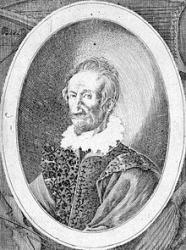
1514 - 1572 Person Name: Claude Goudimel, 1505-1572 Scripture: Luke 11:1 Composer of "TOULON" in The Christian Hymnary. Bks. 1-4 The music of Claude Goudimel (b. Besançon, France, c. 1505; d. Lyons, France, 1572) was first published in Paris, and by 1551 he was composing harmonizations for some Genevan psalm tunes-initially for use by both Roman Catholics and Protestants. He became a Calvinist in 1557 while living in the Huguenot community in Metz. When the complete Genevan Psalter with its unison melodies was published in 1562, Goudimel began to compose various polyphonic settings of all the Genevan tunes. He actually composed three complete harmonizations of the Genevan Psalter, usually with the tune in the tenor part: simple hymn-style settings (1564), slightly more complicated harmonizations (1565), and quite elaborate, motet-like settings (1565-1566). The various Goudimel settings became popular throughout Calvinist Europe, both for domestic singing and later for use as organ harmonizations in church. Goudimel was one of the victims of the St. Bartholomew's Day massacre of Huguenots, which occurred throughout France.
Bert Polman
Claude Goudimel
Edgar L. Maxwell
1878 - 1940 Person Name: Edgar L. Maxwell (1878-1940) Scripture: Luke 11:9 Vers. esp. of "Cuando estés cansado y abatido" in Himnario Adventista del Séptimo Día
Edgar L. Maxwell
John Dykes Bower
1905 - 1981 Person Name: John Dykes Bower, 1905-1981 Scripture: Luke 11:9 Composer of "QUEDGELEY" in Complete Anglican Hymns Old and New Sir John Dykes Bower CVO (13 August 1905 – 1981) was an English cathedral organist, who served in Truro Cathedral, Durham Cathedral and St Paul's Cathedral.
John Dykes Bower was born on 13 August 1905 in Gloucester. He was one of four brothers. Stephen Dykes Bower became a famous church architect.
He was educated at Cheltenham College and studied organ under Herbert Brewer, and was organ scholar at Corpus Christi College, Cambridge from 1922.
He was organist of:
Truro Cathedral 1926 - 1929
New College, Oxford 1929 - 1933
Durham Cathedral 1933 - 1936
St Paul's Cathedral 1936 - 1968
--en.wikipedia.org/wiki/
John Dykes Bower
George Lockwood
b. 1946 Person Name: George Lockwood, b. 1946 Scripture: Luke 11:3 Translator of "Now It Is Evening (Ya Se Oscurece)" in Oramos Cantando = We Pray In Song Rev. George Lockwood was born in 1946 and has been a missionary to Costa Rica. He has pastored Spanish-speaking congregations in both Arizona and California and served on the editorial committee for the Methodist hymnal supplement Celebremos II. In addition, Lockwood has traveled throughout Central and South America interviewing church musicians and gathering new hymns from both Spanish and Portuguese cultures which he then presents at conferences and workshops.
The Presbyterian Hymnal Companion, 1993
George Lockwood
Saint Patrick
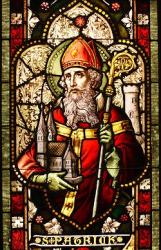
372 - 466 Person Name: St. Patrick Scripture: Luke 11:1 Author of "St. Patrick's Prayer" in Hymns for a Pilgrim People Patrick, St., the 2nd Bishop and Patron Saint of Ireland, was the son of Calpurnius, a deacon, and grandson of Potitus, a presbyter, and great grandson of Odissus, a deacon, was born most probably near Dumbarton, in North Britain, in 372. According to his epistle to Coroticus, his father was also a decurio, a member of the local town council, and a Roman by descent. Hence probably the name Patricius. St. Patrick alludes in Coroticus, § 5, to his having been originally a freeman, and of noble birth. His birthplace is termed in his Confession, § 1, Bannavem Taberniæ. Some have identified that place with Boulogne-sur-Mer, in France. His mother's name was Concessa, said to have been sister of St. Martin of Tours. According to Tirechan's Collections (circa A.D. 690), Patrick had four names—-(1) Magonus, which Tirechan explains by clarus, illustrious; (2) Sucat (Succetus), god of war, or brave in war, said to have been his baptismal name; (3) Patricius; and (4) Cothraige (Cothrighe), given because he had been a slave to four masters. At the age of 16 he was carried off with many others to Ireland, and sold as a slave. There he remained six years with Milcho, or Miliuc. He was engaged in feeding cattle (pecora), though the later writers say that he fed swine. In his captivity he became acquainted with the Irish language. His misfortunes were the means of leading him to Christ, and be devoted himself to prayer, and often frequented, for that purpose, the woods on Mount Slemish. Having escaped after six years, he spent some years with his parents, and then was stirred up, when still a youth (puer), to devote himself to the evangelisation of Ireland. According to Secundinus's Hymn (St. Sechnall), which is probably not much later than the age of St. Patrick himself, the saint received his apostleship "from God," like St. Paul. No reference is made in that hymn, or in the later so-called Hymn of St. Fiacc, to any commission received from Pope Celestine, as is asserted by later writers. St. Patrick does not in his own writings allude to the external source whence he obtained ordination, and, as he speaks of his Roman descent, it would be strange for him not to have mentioned his Roman consecration, if it had been a fact.
From some “sayings" of his, preserved on a separate page of the Book of Armagh, it is probable that he travelled through Gaul and Italy, and that he was ordained in Gaul as deacon, priest, and, afterwards, as bishop. He was probably a bishop when he commenced his missionary labours in Ireland. There were, however, Christians in Ireland before that period. Palladius, the senior Patrick, who preceded our saint by a few years, was, according to the chronicle of Prosper (the secretary of Pope Celestine), "ordained and sent to the Scots (the Irish) believing in Christ, by Pope Celestine, as their first bishop." Palladius's mission was a failure, while that of the second Patrick, which was quite independent of the former, was successful in a high degree. Its success, however, has been greatly exaggerated; for St. Patrick, in the close of his Confession, or autobiography, written in old age, speaks of the high probability of his having to lay down his life as a martyr for Christ. The date of St. Patrick's mission is not certain, but the internal evidence of his writings indicate that it was most probably about A.D. 425. The day and month of his death (March 17), but not the year [466] is mentioned in the Book of Armagh.
St. Patrick's claim to a record in this Dictionary is associated with the celebrated hymn or “Breastplate," a history of which we now subjoin.
1. St. Patrick's Irish Hymn is referred to in Tirechan's Collections (A.D. 690). It was directed to be sung in "all monasteries and churches through the whole of Ireland," "canticum ejus scotticum semper canere," which is a proof that it was at that time universally acknowledged to be his composition. That regulation was very naturally lost sight of when the old Celtic Church lapsed into the Roman, (a) The expressions used in the hymn correspond entirely with the circumstances under which St. Patrick visited Tara. (b) Moreover, although all the ancient biographies of St. Patrick (with the exception of his own Confession, and of Secundinus's Hymn) speak of him as a worker of miracles, and as having performed miracles at Tara, there is no trace of such a fact in St. Patrick's Hymn, (c) Further, the phrase, "creator of doom," which twice occurs in it, according to the most approved translation, curiously corresponds with another fact that, "my God's doom," or “the doom," or "judgment of my God," was, according to the ancient biographies, one of St. Patrick's favourite expressions.
2. The first notice of the existence at the present time of an ancient manuscript copy of St. Patrick's "Hymn or Breastplate," was made known by the late Dr. Petrie in his Memoir of Tara, published in the Transactions of the Royal Irish Academy, 1839, vol. xviii. Dr. Petrie gave the original in Irish characters, an interlineary Latin version and an English translation by himself, together with copious notes. Dr. Petrie found the original in the Liber Hymnorum, in the Library of Trinity College, Dublin (iv. E. 4, 2, fol. 19 b). “The tradition respecting its primary use by the saint is that he recited it on Easter Sunday, when proceeding to encounter the droidical fire-worshippers, with their pagan king, Laoghaire, and his court, at Tara, the royal residence." (Lyra Hibernica Sacra, 1878, p. 2.)
3. Dr. Todd in his work, S. Patrick, Apostle of Ireland, 1864, gives a metrical rendering of the “Breastplate” which begins:—
"I bind to myself today,
The strong power of an invocation of the Trinity,
The faith of the Trinity in Unity,
The Creator of the elements."
The translation, which extends to 78 lines, was mainly the work of Dr. Whitley Stokes. A more correct version by the same scholar is given in the Rolls's edition of the Tripartite Life, 1887; and that revised version, with a few modifications, accompanied with critical notes, explanatory of the alterations made on the former version, is given in the 2nd and 3rd editions of the Writings of St. Patrick, by Dr. V. H. H. Wright. Dr. Whitley Stokes, therefore, is to be regarded as the real translator from the original Irish. Dr. Petrie's translation, though highly meritorious as a first attempt, has been proved in many particulars to be erroneous. There is no mention of Tara in the hymn. An uncertainty yet exists as to the meaning of a few words.
4. In Dr. W. MacIlwaine's Lyra Hibernica Sacra, 1878, Dr. Todd's translation was repeated (with notes), together with a second translation by James Clarence Mangan, the opening lines of which are:—
"At Tara to-day, in this awful hour,
I call on the Holy Trinity!
Glory to Him Who reigneth in power,
The God of the elements, Father, and Son,
And Paraclete Spirit, which Three are the One,
The everlasting Divinity."
5. A popular version of the hymn for congregational use was written by Mrs. Cecil F. Alexander, for St. Patrick's Day, 1889, and sung generally throughout Ireland on that day. The opening lines are:—
"I bind unto myself to-day
The strong Name of the Trinity,
By invocation of the same,
The Three in One and One in Three.
”I bind this day to me for ever,
By power of faith, Christ's Incarnation;
His baptism in Jordan river;
His death on Cross for my salvation;
His bursting from the spiced tomb;
His riding up the heav'nly way;
His coming at the day of doom;
I bind unto myself to-day."
Mrs. Alexander's version is given, along with that of James Clarence Mangan, in the Appendix to the Writinqs of St. Patrick, edited by Dr. C. H. H. Wright (R.T.S.), 1889.
6. Another metrical version of this hymn was given in the Irish Ecclesiastical Gazette for April 5, 1889. It is by Joseph John Murphy, and the opening lines are:—
"I bind as armour on my breast
The Threefold Name whereon I call,
Of Father, Son, and Spirit blest,
The Maker and the Judge of all."
7. The translation in Stokes and Wright's edition of St. Patrick's writings was set to music as a cantata by Sir R. Stewart, and was performed for the first time in St. Patrick's Cathedral, Dublin, on St. Patrick's Day, 1888.
8. Mr. Thomas French, Assistant Librarian of Trinity College, Dublin, writes as follows respecting this hymn:—
"The manuscript called the 'Liber Hymnorum' belonged to Archbishop Ussher, and forms one of the volumes of the Ussher Collection now in the Library of Trinity College, Dublin. There is no interlineary Latin translation in the original. It was given by Petrie in his account of the hymn 'for the satisfaction of the learned’ [The St. Patrick authorship is tradition only, so far as I know.] Dr. Todd in his S. Patrick, Apostle of Ireland, p. 426, says ‘It is undoubtedly of great antiquity, although it may now be difficult, if not impossible, to adduce proof in support of the tradition that St. Patrick was its author.'...... Petrie and Todd make the age of the manuscript 9th or 10th century, Whitley Stokes 11th or 12th."
We may add that St. Patrick's Latin works were published by Sir James Ware, 1656, in the Acta Sanctorum of the Bollandist Fathers, 1668, by Villanueva, 1835, and by others, as B. S. Nicholson, 1868, Miss Cusack, 1871, and, above all, by Dr. Whitley Stokes, in the Rolls' Edition of the Tripartite Life, 1887. The latter three works contain also translations. Translations of the whole, or a portion of St. Patrick's writings, have been published by Rev. T. Olden, 1876; Sir S. Ferguson, LL.D. Transactions of Royal Irish Academy, 1885, and more completely in the Writings of St. Patrick, edited by Prof. G. T. Stokes and Dr. C. H. H. Wright, 1st ed. 1887, 2nd ed. 1888, 3rd ed., edited, with notes critical and historical, and an introduction by Dr. C. H. H. Wright revised and enlarged. London: Religious Tract Society, 1889. [Rev. Charles H. H. Wright, D.D., Ph.D.]
--John Julian, Dictionary of Hymnology (1907)
====================
Patrick, St., p. 885, ii. (l) In the Oxford University Herald of April 6, 1889, is an anonymous paraphrase in 7 stanzas of 4 lines of a portion of "St. Patrick's Hymn," beginning-
"Father, Son, and Holy Ghost!
May Thine overshadowing might
Be as armour to my soul,
Be my weapon in the fight."
(2) Note concerning § 3, on p. 885, i., that Dr., W. Stokes's translation appeared in its original form in the Saturday Review, Sept. 5, 1857. In his Goidilica, Calcutta, 1866, p. 66, in an altered form to that of 1857 and 1864.
--John Julian, Dictionary of Hymnology, Appendix, Part II (1907)
Saint Patrick
Samuel Rodigast
1649 - 1708 Person Name: Samuel Rodigast, 1649-1703 Scripture: Luke 11:9-13 Author of "What God ordains is always good" in Together in Song Samuel Rodigast, son of Johann Rodigast, pastor at Groben near Jena, was born at Groben Oct. 19, 1649. He entered the University of Jena in 1668 (M.A. 1671), and was in 1676 appointed adjunct of the philosophical faculty. In 1680 he became conrector of the Greyfriars Gymnasium at Berlin. While in this position he refused the offers of a professorship at Jena and the Rectorships of the Schools at Stade and Stralsund. Finally, in 1698, he became rector of the Greyfriars Gymnasium, and held this post till his death. His tombstone in the Koster-Kirche in Berlin says he died "die xxix. Mart. a. MDCCVII . . . aetatis anno lix." ...Two hymns have been ascribed to him, on of which has passed into English, viz.:--"Whatever God ordains is right."
--John Julian, Dictionary of Hymnology (1907)
Samuel Rodigast
Henry Lawes
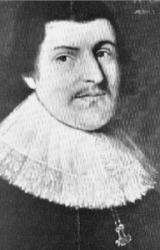
1596 - 1662 Person Name: Henry Lawes, 1595-1662 Scripture: Luke 11:1-4 Composer of "FARLEY CASTLE" in Lutheran Service Book Born: January 5, 1596, Dinton, Wiltshire, England.
Died: October 21, 1662, London, England.
Buried: In the cloisters of Westminster Abbey, London, England.
Lawes, tutor to the daughters of the Earl of Bridgewater, is best known as a composer. He became a Gentleman of the Chapel Royal in 1626, and a member of the "King’s Musick" in 1631. He wrote over 400 vocal pieces, as well as anthems and instrumental compositions. His works include:
Choice Psalmes Put into Musick for Three Voices, 1648
Ayres and Dialogues (London: 1653)
Sources:
Frost, p. 680
Hughes, pp. 467-68
Nutter, p. 460
Stulken, p. 292
--www.hymntime.com/tch
Henry Lawes
Carl Schalk
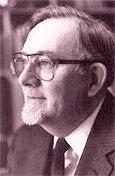
1929 - 2021 Person Name: Carl F. Schalk, b. 1929 Scripture: Luke 11:1-4 Arranger of "FARLEY CASTLE" in Lutheran Service Book Carl F. Schalk (b. Des Plaines, IL, 1929; d. 2021) is professor of music emeritus at Concordia University, River Forest, Illinois, where he taught church music since 1965. He completed graduate work at the Eastman School of Music in Rochester, New York, and at Concordia Seminary, St. Louis, Missouri. From 1952 to 1956 he taught and directed music at Zion Lutheran Church in Wausau, Wisconsin, and from 1958 to 1965 served as director of music for the International Lutheran Hour. Honored as a Fellow of the Hymn Society in the United States and Canada in 1992, Schalk was editor of the Church Music journal (1966-1980), a member of the committee that prepared the Lutheran Book of Worship (1978), and a widely published composer of church music. Included in his publications are The Roots of Hymnody in The Lutheran Church-Missouri Synod (1965), Key Words in Church Music (1978), and Luther on Music: Paradigms of Praise (1988). His numerous hymn tunes and carols are collected in the Carl Schalk Hymnary (1989) and its 1991 Supplement.
Bert Polman
Carl Schalk
Joseph Barnby
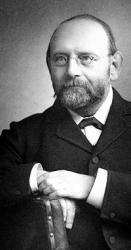
1838 - 1896 Person Name: Joseph Barnby, 1838-1896 Scripture: Luke 11:2-4 Composer of "LAUDES DOMINI" in Worship and Rejoice Joseph Barnby (b. York, England, 1838; d. London, England, 1896) An accomplished and popular choral director in England, Barnby showed his musical genius early: he was an organist and choirmaster at the age of twelve. He became organist at St. Andrews, Wells Street, London, where he developed an outstanding choral program (at times nicknamed "the Sunday Opera"). Barnby introduced annual performances of J. S. Bach's St. John Passion in St. Anne's, Soho, and directed the first performance in an English church of the St. Matthew Passion. He was also active in regional music festivals, conducted the Royal Choral Society, and composed and edited music (mainly for Novello and Company). In 1892 he was knighted by Queen Victoria. His compositions include many anthems and service music for the Anglican liturgy, as well as 246 hymn tunes (published posthumously in 1897). He edited four hymnals, including The Hymnary (1872) and The Congregational Sunday School Hymnal (1891), and coedited The Cathedral Psalter (1873).
Bert Polman
Joseph Barnby


 My Starred Hymns
My Starred Hymns


